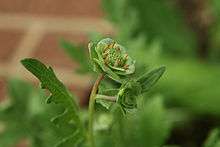Berlandiera lyrata
| Berlandiera lyrata | |
|---|---|
 | |
| Scientific classification | |
| Kingdom: | Plantae |
| (unranked): | Angiosperms |
| (unranked): | Eudicots |
| (unranked): | Asterids |
| Order: | Asterales |
| Family: | Compositae |
| Genus: | Berlandiera |
| Species: | B. lyrata |
| Binomial name | |
| Berlandiera lyrata Benth. | |
| Synonyms[1] | |
|
Berlandiera incisa Torr. & A.Gray | |
Berlandiera lyrata, with the common names chocolate flower, chocolate daisy, or lyreleaf greeneyes, is a North American species of flowering plant in the sunflower family.[2] The common name lyreleaf greeneyes is a reference to the shape of the leaf, which is curved like a lyre and the green disc which is left behind when the ray florets drop off which is thought to look like an eye.[3]
The flower head is approximately the 1.0 inch (2.54 cm) in diameter, with yellow ray florets and which grows with an "airy habit."[4] The leaves are pinnately lobed or scalloped.[5] In areas that freeze, the flowers bloom at night from spring until frost.[3] When the plant freezes, it will "seem to disappear" with the roots alive, but dormant in the soil.[5] In frost-free ares, it will bloom year-round.[3] Around mid-morning, the flowers close or drop.[3] The process of the flower head losing the ray florets is due to a change in temperature: as it gets hotter, the flower begins to turn white and then the ray florets begin to drop, leaving the green disc shape.[5] The plant grows to be about 1–2 feet (30–60 cm) in height.[3]
In the United States, the species is native to Colorado, Kansas, Oklahoma, Arizona, New Mexico and Texas. In Mexico, it is native to Chihuahua, Coahuila, Nuevo León, San Luis Potosí, Durango, Sonora, Zacatecas, Aguascalientes and Jalisco.[6][7][8]
The flower head is known to attract beneficial insects to the garden.[4]
The stamens have a chocolate flavor and are edible.[4][9] The plant was also used by Native Americans to alleviate symptoms of stomach problems.[5] Some Native American cultures would burn the dried roots of the plant in order to treat nervous conditions or to inspire courage.[5]


Cultivation
Berlandiera lyrata is a hardy perennial, cultivated as an ornamental plant. It is grown in gardens for the chocolate-like scent of its flowers.[4] The chocolate odor can also be produced by plucking the ray florets from the flower head.[9] To ensure that it will continue to bloom as long as possible, remove spent flowers (deadheading).[9]
It grows best in full sun locations. It is native to soil types that are dry, shallow and rocky such as sandy loams and limestone soils.[3] It is known to grow along roadsides and in grasslands in the southwest United States.[3] It is drought-tolerant.[3] In heavy, wet soils, B. lyrata is subject to root rot.[9] It can be grown in elevations as 7,000 feet.[5] B. lyrata can be planted in areas that are mowed frequently and can be mowed itself.[9]
The plant is propagated through seeds which can be collected from the plant itself and germinated outdoors from spring to fall.[9]
References
- ↑ The Plant List, Berlandiera lyrata Benth.
- ↑ "Berlandiera lyrata". Flora of North America. Retrieved 2007-10-04.
- 1 2 3 4 5 6 7 8 "Berlandiera lyrata". Missouri Botanical Garden. Retrieved 9 May 2015.
- 1 2 3 4 "Berlandiera lyrata: Chocolate Scented Daisy". Mountain Valley Growers. Retrieved 9 May 2015.
- 1 2 3 4 5 6 "August: Chocolate Flower: Berlandiera lyrata". Santa Fe Botanical Garden. August 2012. Retrieved 9 May 2015.
- ↑ United States Department of Agriculture, Agricultural Research Service, Beltsville Area. "Berlandiera lyrata". Germplasm Resources Information Network (GRIN). Retrieved 2007-10-04.
- ↑ Biota of North America Program 2014 county distribution map
- ↑ Turner, Billie Lee 1988. Phytologia 64(3): 205–208 distribution map on page 208
- 1 2 3 4 5 6 "Berlandiera lyrata". Native Plant Database. Ladybird Johnson Wildflower Center. Retrieved 9 May 2015.
External links
| Wikimedia Commons has media related to Berlandiera lyrata. |